
How to Use Solenoid: Examples, Pinouts, and Specs
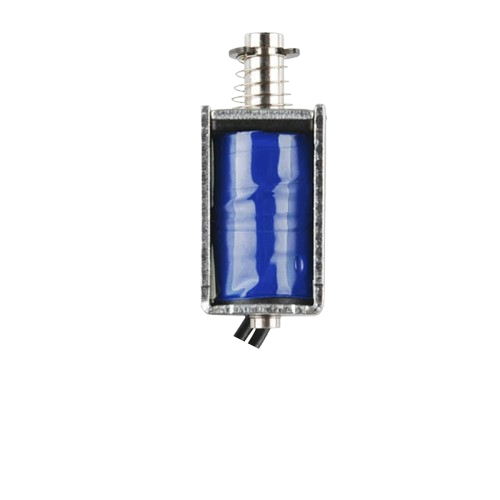
 Design with Solenoid in Cirkit Designer
Design with Solenoid in Cirkit DesignerIntroduction
A solenoid is an electromechanical device that converts electrical energy into linear motion. It consists of a coil of wire that generates a magnetic field when an electric current passes through it. This magnetic field moves a ferromagnetic plunger or core, enabling the solenoid to perform mechanical actions. Solenoids are widely used in applications requiring controlled linear motion, such as controlling valves, actuating mechanical systems, locking mechanisms, and even in automotive starters.
Explore Projects Built with Solenoid
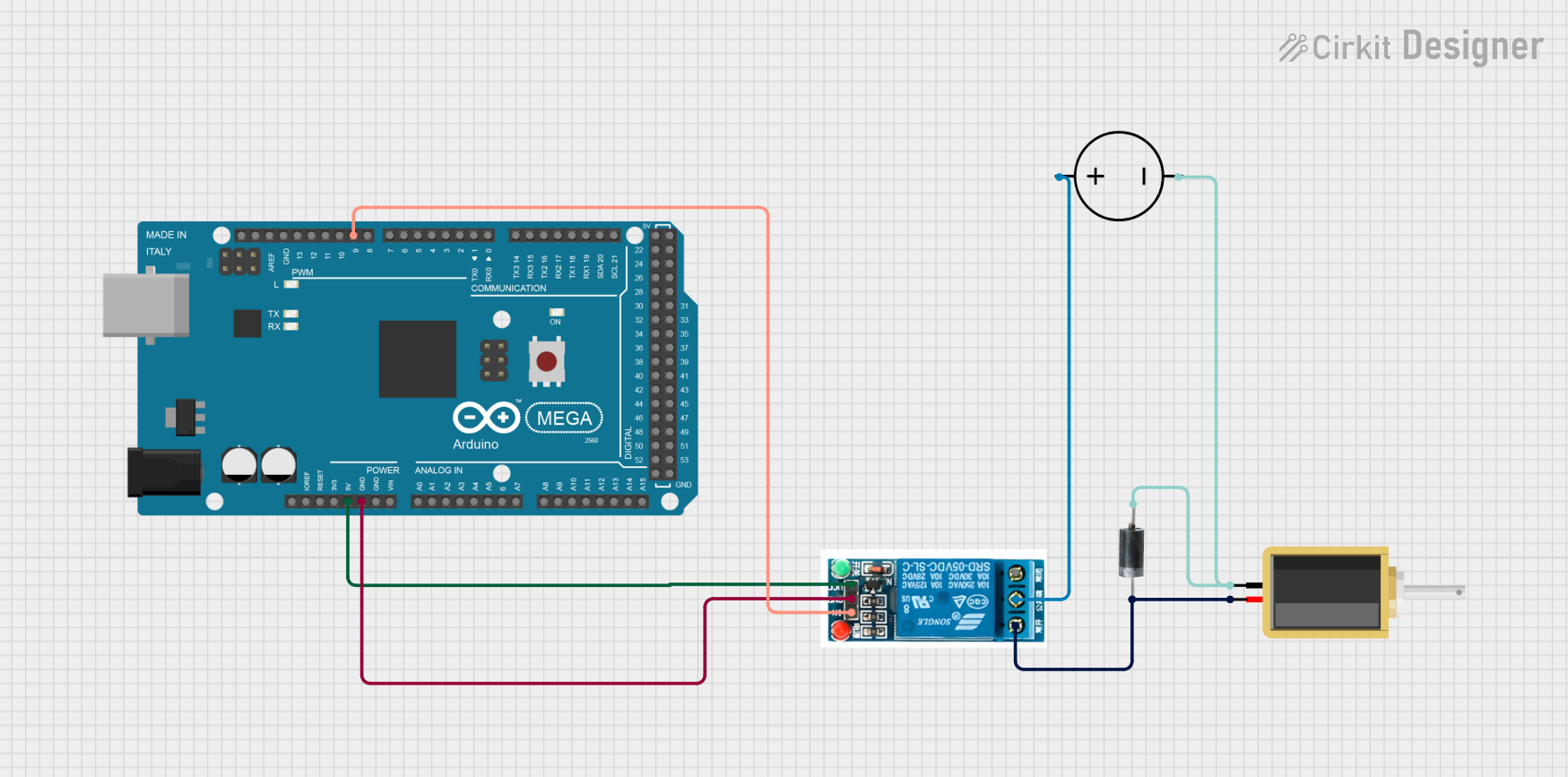
 Open Project in Cirkit Designer
Open Project in Cirkit Designer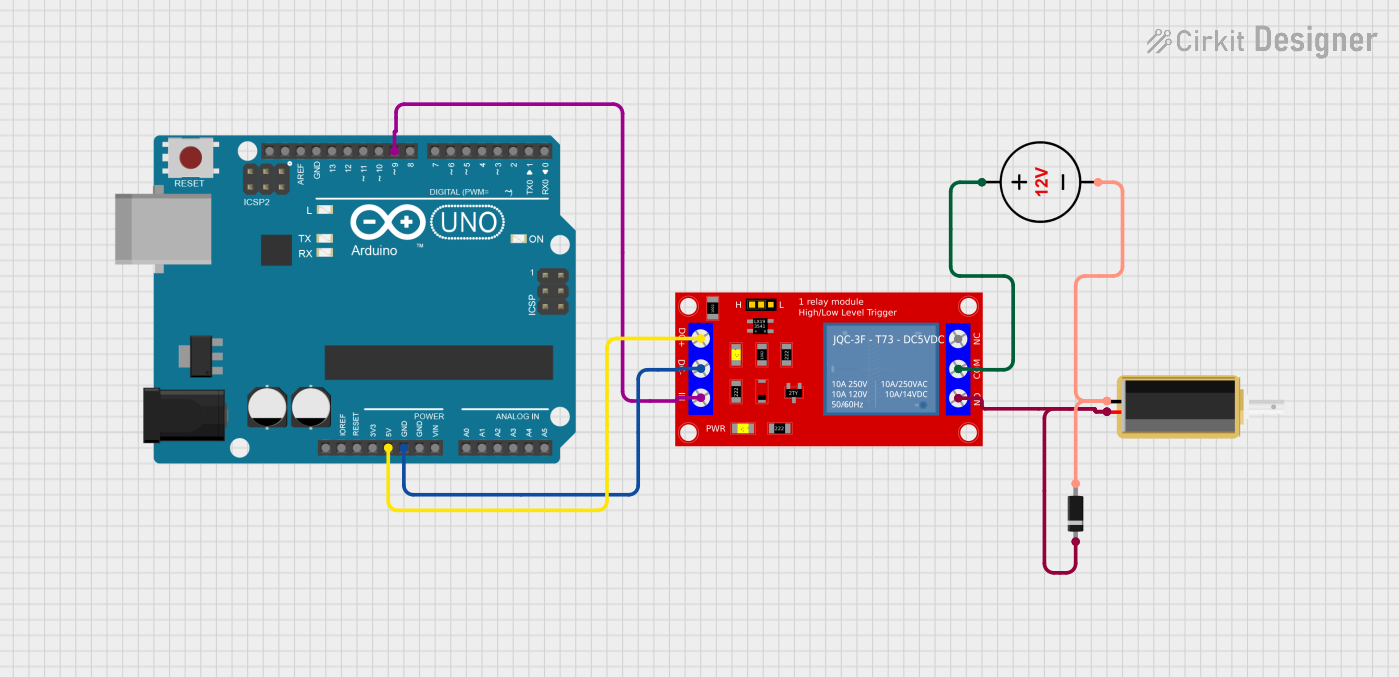
 Open Project in Cirkit Designer
Open Project in Cirkit Designer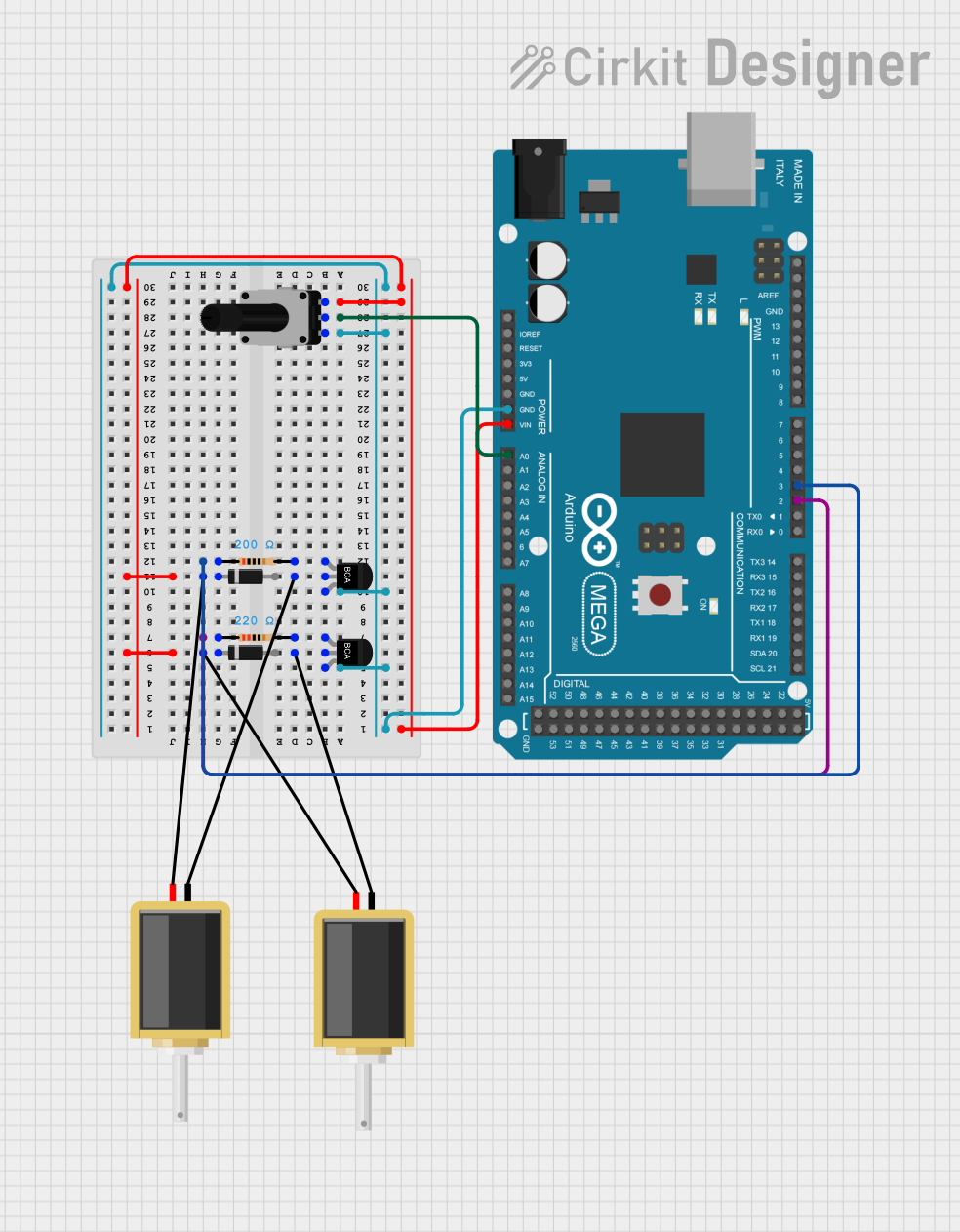
 Open Project in Cirkit Designer
Open Project in Cirkit Designer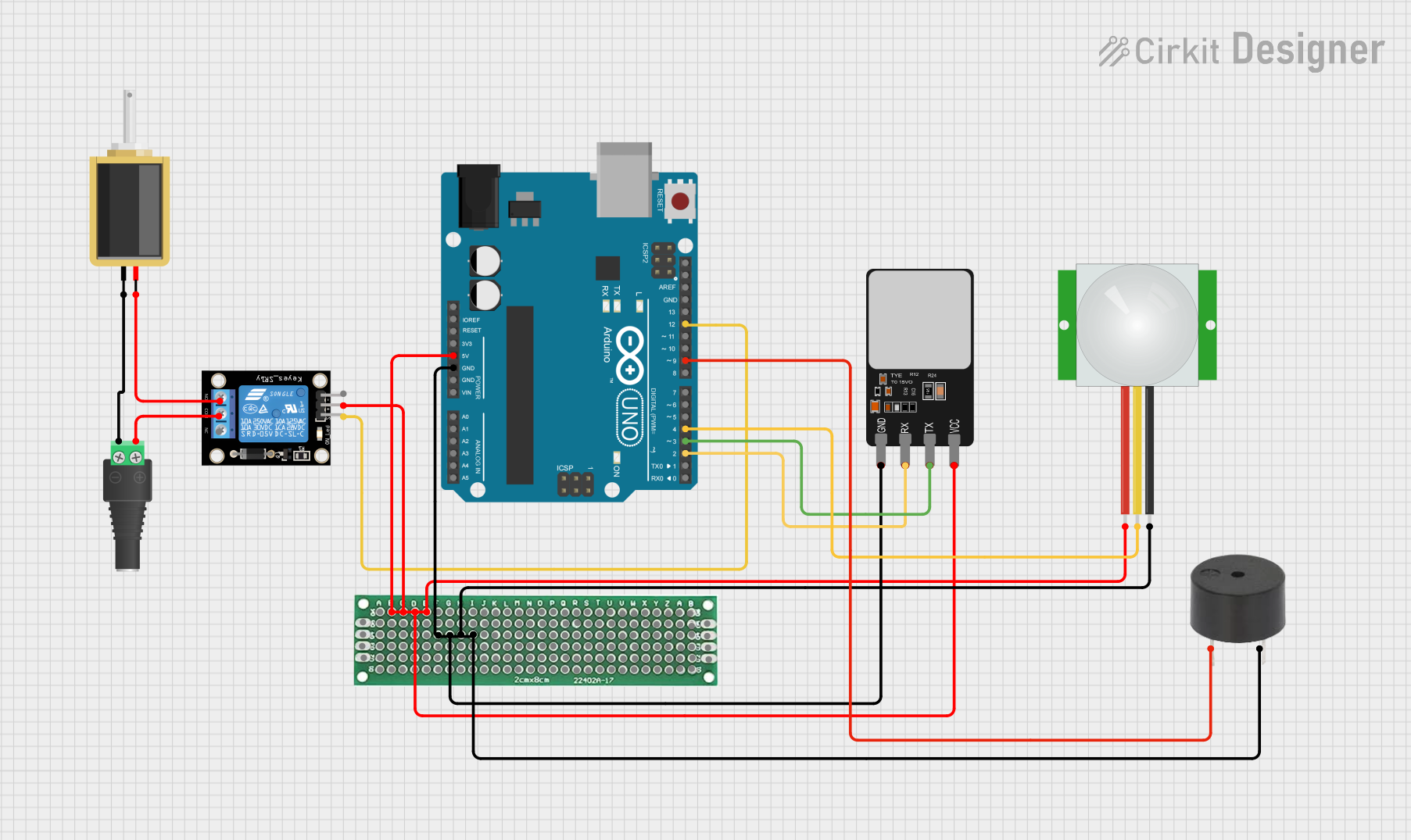
 Open Project in Cirkit Designer
Open Project in Cirkit DesignerExplore Projects Built with Solenoid

 Open Project in Cirkit Designer
Open Project in Cirkit Designer
 Open Project in Cirkit Designer
Open Project in Cirkit Designer
 Open Project in Cirkit Designer
Open Project in Cirkit Designer
 Open Project in Cirkit Designer
Open Project in Cirkit DesignerCommon Applications:
- Valves: Used in fluid control systems to open or close pathways.
- Locks: Found in electronic door locks and security systems.
- Automotive Systems: Starter motors, fuel injectors, and transmission systems.
- Industrial Automation: Actuators in robotic arms and conveyor systems.
Technical Specifications
Below are the general technical specifications for a standard DC solenoid. Note that specific values may vary depending on the solenoid model and manufacturer.
Key Technical Details:
- Operating Voltage: 5V, 12V, or 24V DC (common variants)
- Current Rating: 0.5A to 2A (depending on size and load)
- Power Consumption: Typically 2W to 24W
- Stroke Length: 5mm to 30mm (varies by model)
- Force: 0.5N to 50N (depending on the solenoid type)
- Coil Resistance: Varies with voltage and current rating
- Duty Cycle: Continuous or intermittent (e.g., 25%, 50%, or 100%)
Pin Configuration and Descriptions:
A solenoid typically has two terminals for electrical connections. These terminals are not polarized, meaning you can connect them in either orientation.
| Pin | Description |
|---|---|
| Pin 1 | Positive or negative terminal |
| Pin 2 | Positive or negative terminal |
Note: Some solenoids may include additional components like diodes for flyback protection. Always check the datasheet for your specific solenoid.
Usage Instructions
How to Use a Solenoid in a Circuit:
- Power Supply: Ensure the solenoid is powered by a voltage source that matches its rated voltage (e.g., 12V DC). Using a higher voltage can damage the solenoid.
- Driver Circuit: Solenoids typically require more current than microcontrollers like Arduino can supply directly. Use a transistor, MOSFET, or relay to drive the solenoid.
- Flyback Diode: Always connect a flyback diode across the solenoid terminals to protect the circuit from voltage spikes caused by the collapsing magnetic field when the solenoid is turned off.
- Control Signal: Use a microcontroller or switch to control the solenoid's operation.
Example Circuit with Arduino UNO:
Below is an example of how to control a 12V solenoid using an Arduino UNO, an NPN transistor (e.g., 2N2222), and a flyback diode (e.g., 1N4007).
Circuit Diagram:
- Components:
- Arduino UNO
- 12V solenoid
- NPN transistor (e.g., 2N2222)
- Flyback diode (e.g., 1N4007)
- 1kΩ resistor
- External 12V power supply
Arduino Code:
// Define the pin connected to the transistor's base
const int solenoidPin = 9;
void setup() {
pinMode(solenoidPin, OUTPUT); // Set the solenoid pin as an output
}
void loop() {
digitalWrite(solenoidPin, HIGH); // Activate the solenoid
delay(1000); // Keep it on for 1 second
digitalWrite(solenoidPin, LOW); // Deactivate the solenoid
delay(1000); // Wait for 1 second
}
Important Considerations:
- Power Supply: Ensure the power supply can provide sufficient current for the solenoid.
- Heat Management: Solenoids can heat up during prolonged use. Check the duty cycle rating and avoid exceeding it.
- Mounting: Securely mount the solenoid to prevent movement during operation.
- Noise: Solenoids can produce audible noise when actuated. Consider this in noise-sensitive applications.
Troubleshooting and FAQs
Common Issues and Solutions:
Solenoid Not Activating:
- Cause: Insufficient power supply or incorrect wiring.
- Solution: Verify the power supply voltage and current. Check all connections.
Overheating:
- Cause: Exceeding the solenoid's duty cycle or using the wrong voltage.
- Solution: Use the solenoid within its rated duty cycle and voltage. Allow cooling time if necessary.
Voltage Spikes Damaging Components:
- Cause: Missing or improperly connected flyback diode.
- Solution: Ensure a flyback diode is installed across the solenoid terminals.
Solenoid Buzzing or Vibrating:
- Cause: Insufficient holding current or loose mounting.
- Solution: Check the power supply and securely mount the solenoid.
FAQs:
Q: Can I connect a solenoid directly to an Arduino?
- A: No, solenoids typically require more current than an Arduino can supply. Use a transistor or relay to drive the solenoid.
Q: What is a flyback diode, and why is it necessary?
- A: A flyback diode protects the circuit from voltage spikes caused by the collapsing magnetic field when the solenoid is turned off.
Q: How do I choose the right solenoid for my application?
- A: Consider the required voltage, current, stroke length, force, and duty cycle for your specific use case.
By following this documentation, you can effectively integrate a solenoid into your projects while ensuring safe and reliable operation.